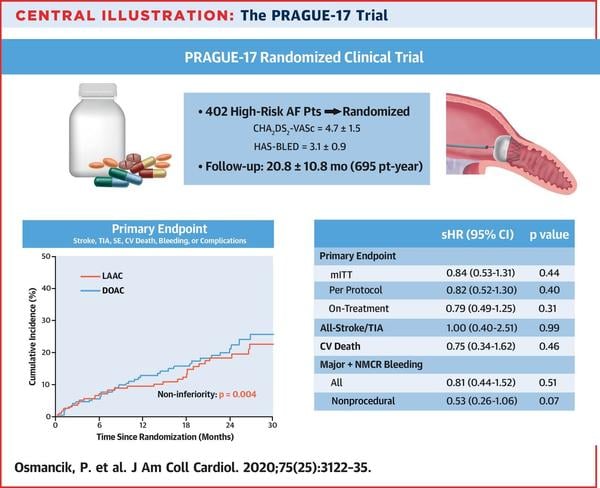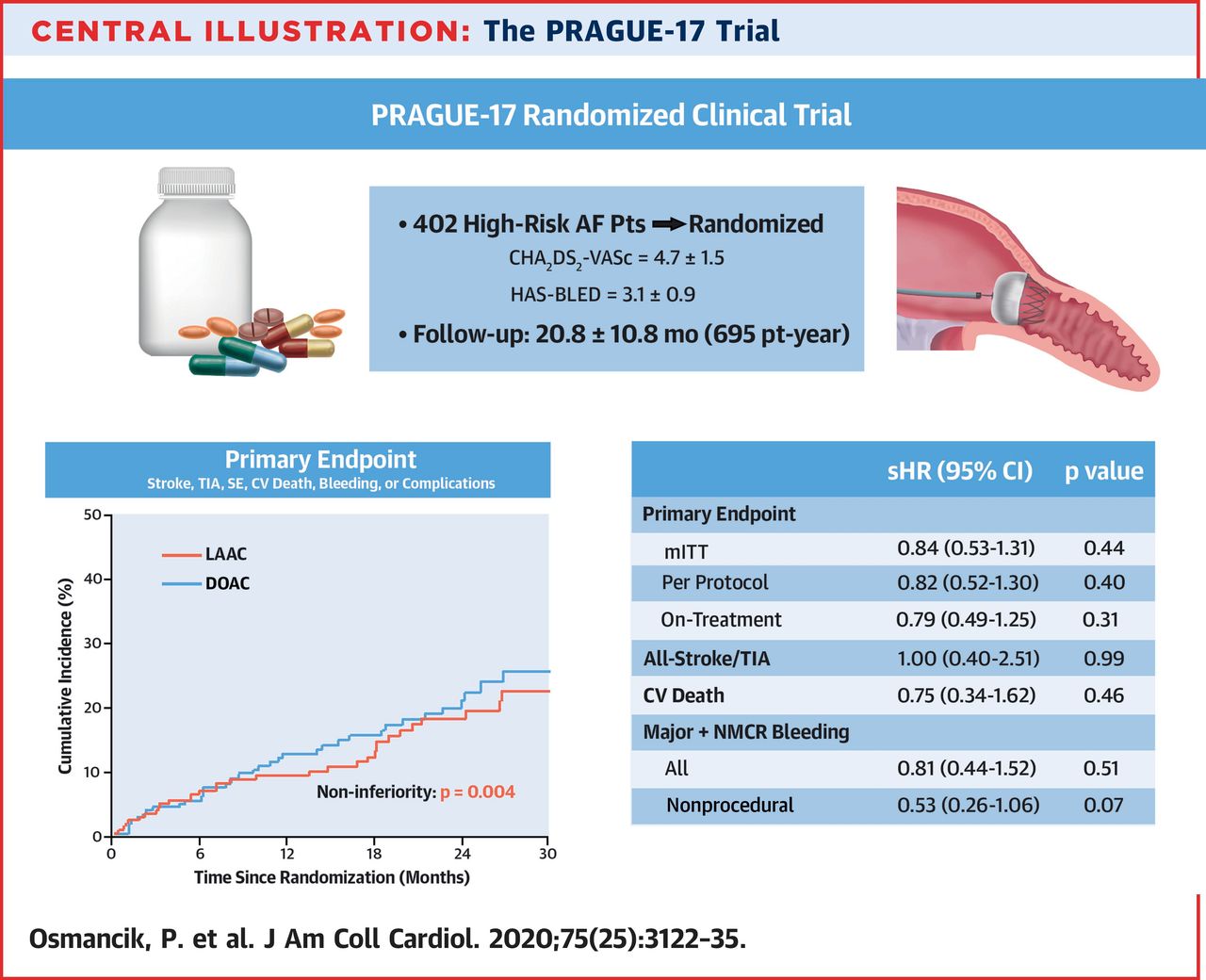Left atrial appendage closure versus direct oral anticoagulants in high-risk patients with atrial fibrillation
Selected in JACC by S. Brugaletta
Although the main finding of the PRAGUE-17 study was of no differences between the two groups in terms of the composite primary endpoint or significant bleeding, there are some other important points to consider.
References
Authors
Osmancik P, Herman D, Neuzil P, Hala P, Taborsky M, Kala P, Poloczek M, Stasek J, Haman L, Branny M, Chovancik J, Cervinka P, Holy J, Kovarnik T, Zemanek D, Havranek S, Vancura V, Opatrny J, Peichl P, Tousek P, Lekesova V, Jarkovsky J, Novackova M, Benesova K, Widimsky P, Reddy VY and on behalf of the PRAGUE-17 Trial Investigators.
Reference
J Am Coll Cardiol. 2020 Jun, 75 (25) 3122-3135.
Published
June 2020
Link
Read the abstractReviewer
Latest contributions
PARTNER 3: transcatheter or surgical aortic-valve replacement in low-risk patients at 7 years 1-year SELUTION DeNovo results: drug-eluting balloon strategy vs. systematic drug-eluting stent in de novo coronary disease Optical coherence tomography- vs angiography-guided coronary stent implantation in calcified lesions: the ILUMIEN IV trialMy Comment
Why this study? – the rationale/objective
Percutaneous left atrial appendage closure (LAAC) is non-inferior to vitamin K antagonists (VKAs) for preventing atrial fibrillation (AF)–related stroke. However, direct oral anticoagulants (DOACs) have an improved safety profile over VKAs and their effect on cardiovascular and neurological outcomes relative to LAAC is unknown. This study sought to compare DOACs with LAAC in high-risk patients with AF.
How was it executed? – the methodology
Left atrial appendage closure vs. novel anticoagulation agents in atrial fibrillation (PRAGUE-17) was a multicentre, randomised, non-inferiority trial comparing LAAC with DOACs.
Patients were eligible to be enrolled if they had nonvalvular AF, were indicated for oral anticoagulation (OAC) and had a history of bleeding requiring intervention or hospitalization, a history of a cardioembolic event while taking an OAC, and/or a CHA2DS2-VASc = or > 3 and HAS-BLED of >2.
Patients were randomised to receive LAAC or DOAC.
The primary composite outcome was stroke, transient ischemic attack, systemic embolism, cardiovascular death, major or nonmajor clinically relevant bleeding, or procedure-/device- related complications. The primary analysis was by modified intention to treat.
What is the main result?
A high-risk patient cohort (CHA2DS2-VASc: 4.7 1.5) was randomised to receive LAAC (n =201) or DOAC (n =201). LAAC was successful in 181 of 201 (90.0%) patients. In the DOAC group, apixaban was most frequently used (192 of 201; 95.5%).
At a median 19.9 months of follow-up, the annual rates of the primary outcome were 10.99% with LAAC and 13.42% with DOAC (subdistribution hazard ratio [sHR]: 0.84; 95% confidence interval [CI]: 0.53 to 1.31; p =0.44; p = 0.004 for noninferiority).
There were no differences between groups for the components of the composite endpoint: all-stroke/TIA (sHR: 1.00; 95% CI: 0.40 to 2.51), clinically significant bleeding (sHR: 0.81; 95% CI: 0.44 to 1.52), and cardiovascular death (sHR: 0.75; 95% CI: 0.34 to 1.62).
Major LAAC-related complications occurred in 9 (4.5%) patients.

Illustration credit: JACC
Critical reading and the relevance for clinical practice
This is the first study comparing LAAC with DOACs.
Although the main finding was of no differences between the two groups in terms of the composite primary endpoint or significant bleeding, there are some important points to consider.
The device used for LAAC was not the same in all the patients, so it is difficult to say if all the devices may work in the same way or if there is a device better than others.
It is also surprising to see a so high incidence of LAAC-related complications (4.5%), which means that it is warranted that operator technique and device technology should further be refined.
Last, but not least, it would be important to understand if these findings might be applied in our daily practice to select the best patient to be treated either by LAAC or by DOAC. In this regard, a cost-effectiveness analysis would be interesting.
How do you manage these patients in your centre? How do you select those for LAAC?





No comments yet!